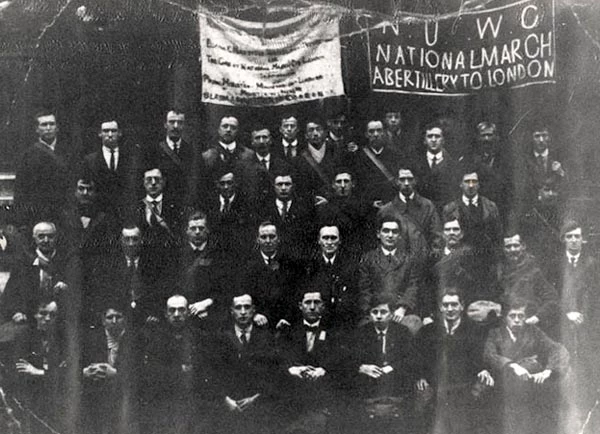A Rhondda rebel song - lyrics discovered from first hunger march in Wales
These lyrics were discovered in the documents of the late grandparents of Ms Powell, Isle of Man, in 2008. See below for transcript. Reproduced with kind permission of Ms Powell.
Abertillery Members of the Hunger March, 1927. [Image: South Wales Coalfield Collection, Swansea University.]
Poster advertising 'Red Sunday in Rhondda Valley' demonstration
The first hunger march from Wales to London took place in 1927 as a protest against the Ministry of Health who were refusing or limiting relief notes to unemployed miners and their families. It was also a demonstration against the Government's new Unemployment Bill.
Red Sunday in Rhondda Valley
During a demonstration on 18 September 1927 — 'Red Sunday in Rhondda Valley' — A. J. Cook, the miners' leader at the time, called for a march to London on 8 November (when Parliament re-opened). Every South Wales Miners' Federation (SWMF) lodge (colliery union branch) chose members to march, and each marcher would carry a miner's safety lamp.
By November the march had lost the support of the SWMF. However, it was still supported by A. J. Cook, S. O. Davies (later MP for Merthyr), the SWMF Rhondda section and the Communist Party.
On 8 November 1927, 270 men eventually marched in spite of hostility from the trades unions, press and government. They did, however, gain support from Trades Councils in every town and village they passed through (which included Pontypridd, Newport, Bristol, Bath, Chippenham and Swindon).
Soldiers in a Workers Army
The 270 marchers came from the Rhondda Valleys, Caerau, Aberdare, Merthyr, Pontypridd, Tonyrefail, Ogmore Valley, Gilfach Goch, Nantyglo and Blaina. Two miners died on the march - Arthur Howe from Trealaw in a traffic accident and John Supple of Tonyrefail who died after catching pneumonia during the rally in Trafalgar Square.
In his last letter to his wife Mr Supple had written — 'Don't worry about me. Think of me as a soldier in the Workers' Army. Remember that I have marched for you and others in want.'
'Fascists' harassment and Armed Escorts
From the beginning, the march was frequently referred to as a 'workers' army'. The marchers had been organized on military lines, divided into detachments and companies. During the march there was alleged harassment by 'Fascists', causing the organizers to be met by an armed escort of 100 members of the Labour League of Ex-Servicemen at Chiswick.
The 'Workers' Army' senior 'officer', Wal Hannington, later wote in a pamphlet entitled 'The March of the Miners: How we Smashed the Opposition': '... these men are lighting a lamp stronger and more powerful than that which they are carrying. They are lighting a lamp that reveals the tortuous path the toilers have had to follow, and which lights up the road of struggle for the battle with the forces of reaction and the conquest of power by the workers'.
The pamphlet includes 'A Rhondda Rebel Song' echoing James Connolly's 'A Rebel Song' which, along with 'March Song of the Red Army' and 'The Red Army March', was sung by the marchers.



Comments - (1)